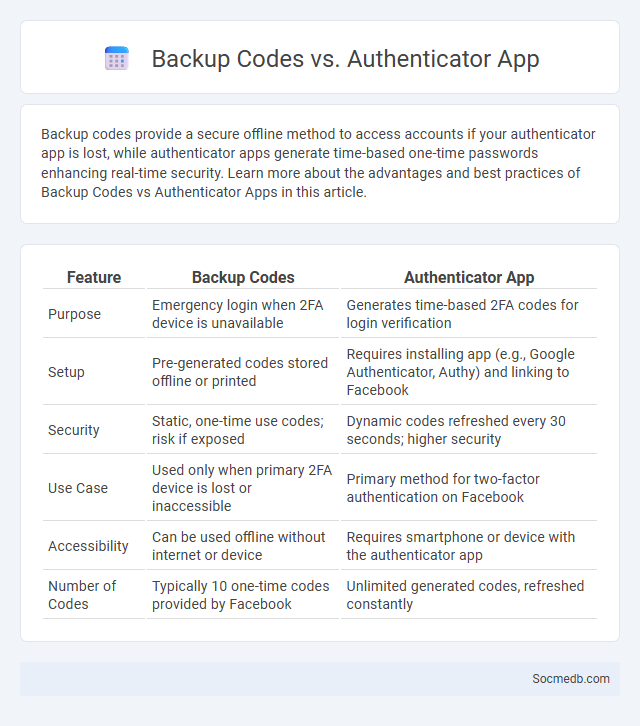
Photo illustration: Backup Codes vs Authenticator App
Backup codes provide a secure offline method to access accounts if your authenticator app is lost, while authenticator apps generate time-based one-time passwords enhancing real-time security. Learn more about the advantages and best practices of Backup Codes vs Authenticator Apps in this article.
Table of Comparison
| Feature | Backup Codes | Authenticator App |
|---|---|---|
| Purpose | Emergency login when 2FA device is unavailable | Generates time-based 2FA codes for login verification |
| Setup | Pre-generated codes stored offline or printed | Requires installing app (e.g., Google Authenticator, Authy) and linking to Facebook |
| Security | Static, one-time use codes; risk if exposed | Dynamic codes refreshed every 30 seconds; higher security |
| Use Case | Used only when primary 2FA device is lost or inaccessible | Primary method for two-factor authentication on Facebook |
| Accessibility | Can be used offline without internet or device | Requires smartphone or device with the authenticator app |
| Number of Codes | Typically 10 one-time codes provided by Facebook | Unlimited generated codes, refreshed constantly |
Introduction to Account Security Methods
Protecting your social media accounts requires implementing strong security methods such as two-factor authentication, unique passwords, and regular account activity monitoring. Enabling these features helps prevent unauthorized access and reduces the risk of data breaches. Your proactive approach to account security strengthens privacy and ensures a safer online experience.
What Are Backup Codes?
Backup codes are a security feature designed to help you regain access to your social media accounts if you lose your primary authentication method, such as your phone or authentication app. These one-time use codes are typically generated by the platform during two-factor authentication (2FA) setup and should be stored securely in case of emergencies. Utilizing backup codes ensures continuous account protection and prevents lockout during unexpected access issues.
Understanding Authenticator Apps
Authenticator apps enhance social media security by providing two-factor authentication (2FA), requiring users to enter a time-sensitive code alongside their password. These applications, such as Google Authenticator, Microsoft Authenticator, or Authy, generate unique verification codes that mitigate risks of unauthorized access and phishing attacks. Integrating authenticator apps into social media accounts significantly strengthens account protection and user privacy.
Exploring Two-Factor Authentication (2FA)
Two-Factor Authentication (2FA) enhances social media security by requiring two separate forms of verification, such as a password and a code sent to your phone, reducing the risk of unauthorized account access. Implementing 2FA protects your personal information from hackers and helps maintain control over your social media profiles. You should enable 2FA on all platforms supporting it, including Facebook, Instagram, and Twitter, to significantly strengthen account protection.
Backup Codes vs Authenticator Apps: Key Differences
Backup codes provide a static, one-time use alternative for two-factor authentication, allowing account access when primary methods fail, while authenticator apps generate dynamic, time-based one-time passwords (TOTPs) to enhance security continuously. Backup codes are typically printed or saved offline and can be used without an internet connection, whereas authenticator apps require a smartphone and periodic synchronization to function properly. Both methods significantly reduce the risk of unauthorized access, but authenticator apps offer stronger protection due to regularly changing verification codes.
Security Strength: 2FA vs Single-Factor Methods
Social media accounts secured with Two-Factor Authentication (2FA) provide a significantly higher level of protection compared to single-factor methods like passwords alone. By requiring a second verification step, such as a code from an authenticator app or a text message, 2FA drastically reduces the risk of unauthorized access and data breaches. You can safeguard your personal information and digital identity more effectively by enabling 2FA on all your social media platforms.
Pros and Cons of Backup Codes
Backup codes provide a secure way to regain access to your social media accounts if you lose your primary authentication method, ensuring you maintain control and avoid lockouts. However, if these codes are lost or stolen, they can pose a security risk by allowing unauthorized access. You should store backup codes in a safe, offline location to maximize their effectiveness and minimize potential vulnerabilities.
Advantages and Limitations of Authenticator Apps
Authenticator apps enhance social media security by providing two-factor authentication (2FA), reducing the risk of unauthorized access and account breaches. They generate time-sensitive, unique codes that are more secure than SMS-based methods and prevent phishing attacks efficiently. However, limitations include dependency on the user's device, potential loss of access if the device is lost or reset, and the need for manual setup, which may hinder adoption among less tech-savvy users.
Which Authentication Method Should You Choose?
Choosing the right social media authentication method depends on your security needs and user convenience. Multi-factor authentication (MFA) offers robust protection by requiring multiple verification steps, reducing the risk of unauthorized access. Your account's safety improves significantly when you select authentication methods like SMS codes, authenticator apps, or biometric verification tailored to your platform's capabilities.
Best Practices for Enhanced Online Security
Implementing strong, unique passwords and enabling two-factor authentication are essential best practices for enhanced online security on social media platforms. Regularly updating privacy settings to limit profile visibility and personal information exposure helps protect against unauthorized access. Staying vigilant for phishing attempts and suspicious links reduces the risk of account compromise and data breaches.
 socmedb.com
socmedb.com